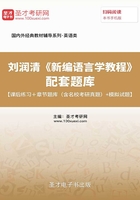
第2章 语 音
1.Define the following terms briefly.
Key:
·Articulator: Different parts of the vocal tract involved in the production of speech sound are called organs of speech or articulators, including lips, teeth, alveolar ridge, hard palate, soft palate, tongue, uvula and vocal cords.
·Assimilation: Assimilation refers to the way that sounds belonging to one word or one syllable can cause changes in sounds belonging to neighboring sounds or syllables. There are two kinds of assimilation. It is called regressive assimilation when the changes were brought about by the following sound; while changes brought about by the preceding sound is called progressive assimilation.
·Consonant: Consonants are sounds in which there is obstruction to the flow of air as it passes from the larynx to the lips. There are altogether 24 consonants in English.
·Elision: Elision refers to the loss of a sound or sounds in speech under certain circumstances. It is typical of rapid, casual speech.
·Intonation: Intonation refers to a greater degree of loudness and the change of speech rhythm in the utterance of some syllables.
·Phoneme: Phoneme is the abstract element of a sound, identified as being distinctive in a particular language. It is the smallest phonological unit of language which can distinguish meaning.
·Phonetics: The study of the speech sounds that occur in all human languages is called phonetics. The study of phonetics can be divided into three main branches: articulatory phonetics, auditory phonetics and acoustic phonetics.
·Phonology: Phonology is the description of the systems and patterns of speech sounds in a language.
·Stress: When a word has more than one syllable, one of them will be pronounced with more prominence than others and this speech sound phenomenon is called stress.
·Voicing: Voicing is a distinctive phonetic feature of speech sound that can distinguish one word from another, which refers to the vibration in the larynx caused by air fro the lungs passing through the vocal cords when they are partly closed. A speech sound can be defined as voiced or voiceless. For example, the only difference between [z] and [s] is voicing.
·Voiceless: One of the two branches in voicing. It is used to describe sounds produced without causing vibration of the vocal cords.
·Vowel: Vowels are sounds in which there is no obstruction to the flow of air as it passes from the larynx to the lips. There are altogether 21 vowel sounds in English.
2.What is the test most often used for determining phonemes in a language? Illustrate how the test works with examples.
Key: The minimal pair test or substitution test is the first rule of thumb to determine the phonemes of any language, that is, to see whether substituting one sound for another result in a different word. If it does, the two sounds represent different phonemes. For example, we see from the contrast between fine and vine and between chunk and junk that [f], [v], [tʃ] and [dʒ] must be phonemes in English because substituting [v] for [f], or [dʒ] for [tʃ] produce a different word.
3.What’s the difference between an open and a closed syllable?
Key: The units, which are often longer than one sound and smaller than a whole word, are called syllables. Syllables can be divided into two sorts: the open syllables and the closed syllables. Syllables like me, by or no that have an onset and a nucleus, but no coda are called open syllables; while the coda is present in the syllables like up, cup or hat, which is called closed syllables.
4.For each group of sounds listed below, state the phonetic feature or features which they share.
Example: [p] [b] [m]→Feature: bilabial, stop, consonant
(1) [g][p][t][d][k][b]
(2) [u][u:][C]
Key: (1) [g][p][t][d][k][b] →shared features: stop, consonant.
(2) [u][u:][C]→shared features: back, rounded, vowel.
5.Name the single feature that distinguishes the following pairs of sounds.
(1) [ð] : [θ]
(2) [p] : [f]
(3) [I] : [e]
(4) [b] : [m]
(5) [s] : [ʃ]
(6) [s] : [ð]
Key: (1) [ð] : [θ]→voicing. (voiceless vs. voiced)
(2) [p] : [f]→place of articulation. (bilabial vs. labio-dental)
(3) [I] : [e]→the height of the tone rising. (high vs. mid)
(4) [b] : [m]→manner of articulation. (stop vs. nasal)
(5) [s] : [ʃ]→place of articulation. (alveolar vs. palatal)
(6) [s] : [ð]→place of articulation. (alveolar vs. dental)
6.The following sets of minimal pairs show that English [p] and [b] contrast in initial, medial and final positions.
![]()
Find similar sets of minimal pairs for each pair of consonants given:
(1) [k]-[g]
(2) [m]-[n]
(3) [b]-[v]
(4) [b]-[m]
(5) [p]-[f]
Key:

7.The English data below provide examples of stress placement on certain verbs.

(1) Describe in words the stress placement on these verbs. Make sure you refer to syllable structure in your statement.
(2) Provide syllable representations of the words col’lide, e’lect, and con’sider in order to illustrate your conclusion about stress placement in these forms.
Key: (1) Stress in languages may be predictable by rules: lexical category, morphological structure and number of syllables all seem to be relevant factors for the placement of stress in English words.
For two-syllable verbs, the final (ultimate) syllable will receive main stress if it has a long vowel or ends in at least two consonants. In this case, the first (penultimate) syllable may have secondary stress, contain an unstressed full vowel, or contain a reduced vowel. For example, a’dapt, e’lect.
If the ultimate syllable does not have a long vowel or end in two or more consonants, the penultimate syllable is stressed, as in ‘promise. Otherwise, the main stress will be put on the second syllable. For example, ca’rouse, ob’serve, as’tonish, de’termine.
If there is a double-letter in the word, the main stress should be put between them, or in other words, on the second one of the two. Such as ap’pear, cor’rode, col’lide, col’lapse.
(2) They are two-syllable words; therefore the final (ultimate) syllable will receive main stress, as col’lide, e’lect and con’side.
